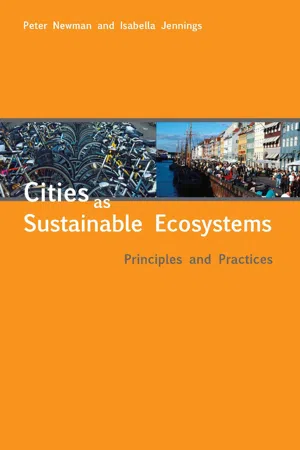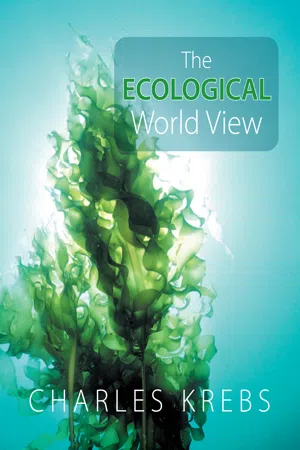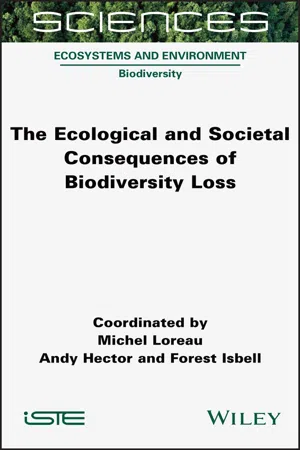Biodiversity
Biodiversity refers to the variety of life forms within a specific ecosystem, including diversity at the genetic, species, and ecosystem levels. It encompasses the multitude of different species, their genetic variations, and the complex interactions between them. Biodiversity is crucial for ecosystem stability, resilience, and the provision of ecosystem services essential for human well-being.
8 Key excerpts on "Biodiversity"
- eBook - ePub
Cities as Sustainable Ecosystems
Principles and Practices
- Peter Newman, Isabella Jennings(Authors)
- 2012(Publication Date)
- Island Press(Publisher)
...The complexity of ecosystems and the biosphere is highlighted by de Duve: Even the simplest fields or ponds are multifactorial systems stitched together into intricate networks by dynamic interactions among the plants, animals, fungi, and microorganisms they contain. Such systems, in turn, join to create larger, more complex fabrics, eventually closing into a single, gigantic web of formidable complexity that envelops the entire Earth: the biosphere. (1995, 217) Biological diversity—or Biodiversity—is the term given to the variety of life on Earth and the natural patterns it forms, encompassing the full range of species, genetic variation, and ecosystems in a given place. Living communities form patterns of complex interactions and relationships with each other and their life-places. These ecosystems occur over a broad range of scales. The biosphere can be divided into biomes: large-scale ecosystems characterized by vegetation type and climatic characteristics, including deserts, different types of forests, mountains, and grasslands. Tropical forests, coral reefs, and Mediterranean heathlands are the most species-rich ecosystems (UNEP 2002). While about 1.75 million species have been identified to date, mostly small invertebrates, estimates suggest that there may be as many as 14 million species (UNEP 2002). 1 The Value of Biodiversity Biodiversity—the variability within and among living organisms and the systems they inhabit—is the foundation upon which human civilization has been built. In addition to its intrinsic value, Biodiversity provides goods and services that underpin sustainable development in many important ways, thus contributing to poverty alleviation. First, it supports the ecosystem functions essential for life on Earth, such as the provision of fresh water, soil conservation, and climate stability. Second, it provides products such as food, medicines, and materials for industry...
- Justin Garson, Anya Plutynski, Sahotra Sarkar, Justin Garson, Anya Plutynski, Sahotra Sarkar(Authors)
- 2016(Publication Date)
- Routledge(Publisher)
...Rather, ‘‘Biodiversity’’ in the broad sense (Hubbell’s “‘Biodiversity’ in policy parlance”) refers to a plurality of biological diversities, some of which are valued in particular contexts, many of which are of interest to biologists. Indeed, the diversities that we see at multiple scales in the biological world are what the life sciences purport to explain (think of Darwin’s “tangled bank” and “endless forms”), and there are longstanding research traditions showing that certain types of diversity, and their absence, can have important effects. 4 There have also been proposals that increasing diversity is a kind of “zero-force evolutionary law” of biology, as biological systems left alone will spontaneously differentiate through random mutation, copying errors, etc. (McShea and Brandon 2010). Whether or not this proposal should be accepted, evolutionary biologists have long understood diversity within populations to be the “raw material” of evolutionary change. In conservation contexts, since loss of any species or ecosystem constitutes a loss of diversity, concerns about species and ecosystem loss are easily translated into concerns about declining Biodiversity. ‘‘Biodiversity’’ in the broad sense thus groups biological diversities across scientific contexts (evolutionary biology, ecology, etc.) and broader social contexts (conservation biology, environmental policy, etc.) under a single heading, even while our interests in the diversities of life are many and multifaceted. Thus the only constraints on the use of ‘‘Biodiversity’’ across contexts seem to be that (1) the entities, systems, or processes in question are biological; and (2) there is at least implicit reference to variety or heterogeneity. 5 The first constraint rules out, say, geological or chemical heterogeneity from falling under the broad Biodiversity concept, although there are borderline cases when one considers systems at the margins of life (Malaterre 2013)...
- eBook - ePub
- Rattan Lal(Author)
- 2017(Publication Date)
- CRC Press(Publisher)
...Biodiversity and Sustainability Odo Primavesi Brazilian Corporation of Agricultural Research (EMBRAPA), Sao Paulo, Brazil Abstract The discussion on sustainability and Biodiversity is focused at the level of the economic, agricultural, and policy sectors. However, there are different interpretations about this discussion, depending on the point of view of the party presenting the argument. In this entry, a global view is given to better understand the specificity based on the ecological principles that run nature. These principles remain as the source of inspiration and reference for the development of useful concepts to promote life and its quality. Biodiversity What Is Biodiversity? The U.N. Convention on Biological Diversity defines biological diversity as “the variability among living organisms from all sources, including terrestrial, marine, and other aquatic ecosystems and the ecological complexes of which they are part; this includes diversity within species, between species, and of ecosystems.” [ 1 ] Table 1 shows the global measured and estimated Biodiversity in the world ecosystem. Diversity is considered at different levels, between individuals, subspecies, species (most useful level), biological communities, and ecosystems. Species richness increases from colder to warmer latitudes...
- eBook - ePub
Biodiversity and Conservation
Characterization and Utilization of Plants, Microbes and Natural Resources for Sustainable Development and Ecosystem Management
- Jeyabalan Sangeetha, Devarajan Thangadurai, Goh Hong Ching, Saher Islam, Jeyabalan Sangeetha, Devarajan Thangadurai, Goh Hong Ching, Saher Islam(Authors)
- 2019(Publication Date)
- Apple Academic Press(Publisher)
...CHAPTER 1 Biodiversity: CONCEPTS, BENEFITS, AND VALUES FOR ECONOMIC AND SUSTAINABLE DEVELOPMENT EITIMAD HSHIM ABDEL-RAHMAN AHMED 1 and ABDELRAHMAN ELTAHIR AHMED MUSA 2 1 Biology Department, Hail University, Hail, 2400, Kingdom of Saudi Arabia 2 Biology Department, Khartoum University, Khartoum, 11115, Sudan 1.1 CONCEPTS OF Biodiversity The word “Biodiversity” is a synonym for Biodiversity around us, i.e., in biological systems the sum of the total of life forms at all levels of organization (Lovejoy, 1980; Norse and McManus, 1980; Wilson, 1988; Heywood, 1995). Through this, we can have an idea about the variation or variability among living organisms and of the systems of which they are part. Thus, this covers the total range of variation and variability among systems and organisms at the bioregional, landscape, ecosystem, habitat, and organismal level down to species, molecules, and genes (Heywood, 1995). In the early 1980s, the term ‘biological diversity’ began to use. Lovejoy (1980) first attributed the term whoever did not provide any formal definition of Biodiversity, but only focus on species richness (number of different species in a location/sample). In the same year Norse and McManus (1980), included ecological and genetic diversity. After that, Rosen used the term “Biodiversity” during the first planning conference of the “National Forum on Biodiversity” at Washington, DC, on September 1986. Edward O...
- eBook - ePub
Economic Valuation of Biodiversity
An Interdisciplinary Conceptual Perspective
- Bartosz Bartkowski(Author)
- 2017(Publication Date)
- Routledge(Publisher)
...Accordingly, there exist many approaches to defining Biodiversity, which encompasses numerous levels and dimensions, including species diversity, genetic diversity, ecosystem diversity, functional diversity. In Chapter 5 we will return to the issue of defining Biodiversity. In addition to a presentation of various definitions and the difficulties related to defining Biodiversity, it was shown in this chapter how Biodiversity can be measured. This discussion will feed into numerous arguments further on in this book, including the critical evaluation of Biodiversity proxies used in economic valuation studies and the attempt to provide some insights about how the conceptual framework to be developed in Chapter 5 can be coupled with empirical data. An important subject of this chapter was Biodiversity’s ecological value. Building upon current ecological literature, it was shown that Biodiversity is correlated with ecosystem functioning, particularly with ecosystem stability...
- eBook - ePub
- Charles Krebs(Author)
- 2008(Publication Date)
- CSIRO PUBLISHING(Publisher)
...Over a hundred years ago, Alfred Wallace recognized that animal and plant life was on the whole more abundant and varied in the tropics than in other parts of the globe. Other patterns of variation have long been known—small or remote islands have fewer species than large islands or those nearer continents. Ecologists try to describe and explain these trends in Biodiversity as a first step in understanding ecological communities. Biodiversity is now an everyday term in newspapers and television reports, and the preservation of Biodiversity has become a public goal in many countries. Biodiversity measurement is important because without an inventory of species we cannot decide on conservation goals. While conservation biologists often worry about one particular species, such as the giant panda, community ecologists tend to group the species and condense information into counts of number of species. This community-based approach looks for large patterns in groups of species and tries to understand what has caused them. To do this, we first need to know how to identify species of plants and animals and then how to measure Biodiversity. Measurement of Biodiversity The concept of Biodiversity can be applied at several ecological levels. We can speak of genetic diversity within a species—this is one form of Biodiversity that is important because of local adaptation of species to their environment. At the next level, species diversity is the more usual concept of Biodiversity, and refers to the variety of species that are found in a community. Community and ecosystem Biodiversity can also be measured as the diversity of ecological communities and ecosystems in a landscape. We shall confine our discussion of Biodiversity here to the diversity of species in a community. Figure 12.1 Species richness of Lepidoptera collections (moths and butterflies) at Rothamsted Experimental Station in England in relation to sample size...
- eBook - ePub
- Michael J. Jeffries(Author)
- 2006(Publication Date)
- Routledge(Publisher)
...(ed.) Biodiversity. National Academy Press, Washington, DC. The classic publication that ignited so much work. Wilson, E.O. (1992) The Diversity of Life. Harvard University Press, Cambridge, MA. Beautifully simple and clear exploration of ecology and evolution. The journal Biodiversity and Conservation should also be essential reading. Not only are individual articles relevant but also there have been many special editions covering topics such as zoos, reintroduction programmes and sustainable use of wildlife. Websites Convention on Biological Diversity: www.biodiv.org/ The Convention’s own website and gateway to a wealth of information. Department of the Environment, Food and Rural Affairs: www.defra.gov.uk/corporate/ sdstratgey/chapter3.htm/ (March 2004) The UK government ministry uses wildlife as one of several indicators of quality of life. Global Biodiversity Forum: www.gbf.ch/ Global Biodiversity Information Facility: www.gbif.net/ International Institute for Environment and Development: www.iied.org/ Good site showing Biodiversity in a wider context of global sustainable development. IUCN (The World Conservation Union): www.iucn.org/ A wealth of information. Johannesburg summit: www.johannesburgsummit.org/ (June 2004) United Nations: www.un.org/ Well worth checking to keep up with the continuing saga of Biodiversity in the context of global politics. United Nations Environment Programme – World Conservation Monitoring Centre. www.unep-wcmc.org A wealth of information. Specific topics Origins and concepts Ghilharov, A. (1996) What does ‘Biodiversity’ mean – scientific problem or convenient myth? Trends in Ecology and Evolution, 11: 304–306. Biodiversity has become so ubiquitous that the concept may be unhelpful. Harper, J.L. and Hawksworth, D.L. (1995) Preface. In Biodiversity: Measurement and Estimation. Chapman and Hall, London. Reviews origins and rise of the term Biodiversity. Lovejoy, T.E. (1980) Changes in Biological diversity. In G.O...
- Michel Loreau, Andy Hector, Forest Isbell(Authors)
- 2022(Publication Date)
- Wiley-ISTE(Publisher)
...Biodiversity and ecosystem functioning in dynamic landscapes.Philosophical Transactions of the Royal Society B, 371, 20150267.Buchmann, T., Schumacher, J., Ebeling, A.et al. (2018). Perspectives in plant ecology, evolution and systematics connecting experimental Biodiversity research to real-world grasslands.Perspect. Plant Ecol. Evol. Syst., 33, 78–88.Butsic, V., Lewis, D.J., Radeloff, V.C., Baumann, M., Kuemmerle, T. (2017). Quasi-experimental methods enable stronger inferences from observational data in ecology.Basic Appl. Ecol., 19, 1–10.Byrnes, J.E.K., Gamfeldt, L., Isbell, F.et al. (2014). Investigating the relationship between Biodiversity and ecosystem multifunctionality: Challenges and solutions.Methods Ecol. Evol, 5, 11–124.Ceballos, G., Ehrlich, P.R., Barnosky, A.D., García, A., Pringle, R.M., Palmer, T.M. (2015). Accelerated modern human-induced species losses: Entering the sixth mass extinction.Sci. Adv., 1, e1400253.Chase, J.M. (2010). Stochastic community assembly causes higher Biodiversity in more productive environments.Science, 328, 1388–1391.Chase, J.M., Abrams, P.A., Grover, J.P.et al. (2002). The interaction between predation and competition: A review and synthesis.Ecol. Lett., 5, 302–315.Chen, S., Wang, W., Xu, W.et al. (2018). Plant diversity enhances productivity and soil carbon storage.Proc. Natl. Acad. Sci. U.S.A., 115, 4027–4032.Chen, L., Jiang, L., Jing, X.et al. (2021). Above- and belowground Biodiversity jointly drive ecosystem stability in natural alpine grasslands on the Tibetan Plateau.Glob. Ecol. Biogeogr, 30, 1418–1429.Connell, J.H. and Orias, E. (1964). The ecological regulation of species diversity.Am. Nat., 98, 399–414.Dee, L.E., Miller, S.J., Peavey, L.E.et al. (2016). Functional diversity of catch mitigates negative effects of temperature variability on fisheries yields.Proceedings of the Royal Society B, 283, 20161435.Díaz, S., Tilman, D., Fargione, J.et al. (2006). Biodiversity regulation of ecosystem services...







